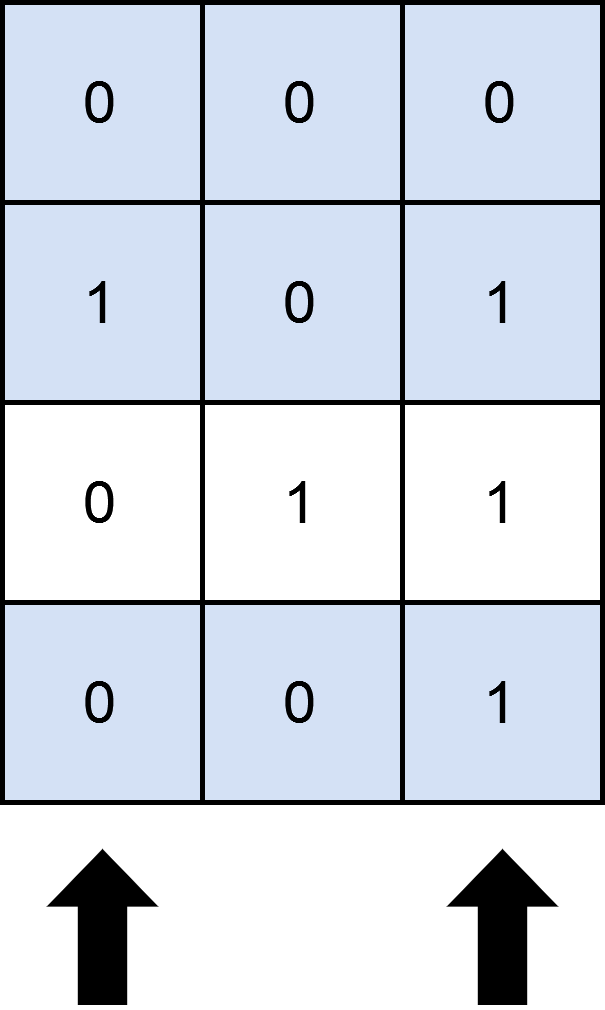You are given a 0-indexed m x n binary matrix matrix and an integer numSelect, which denotes the number of distinct columns you must select from matrix.
Let us consider s = {c1, c2, ...., cnumSelect} as the set of columns selected by you. A row row is covered by s if:
- For each cell
matrix[row][col](0 <= col <= n - 1) wherematrix[row][col] == 1,colis present insor, - No cell in
rowhas a value of1.
You need to choose numSelect columns such that the number of rows that are covered is maximized.
Return the maximum number of rows that can be covered by a set of numSelect columns.
Example 1:
Input: matrix = [[0,0,0],[1,0,1],[0,1,1],[0,0,1]], numSelect = 2
Output: 3
Explanation: One possible way to cover 3 rows is shown in the diagram above.
We choose s = {0, 2}.
- Row 0 is covered because it has no occurrences of 1.
- Row 1 is covered because the columns with value 1, i.e. 0 and 2 are present in s.
- Row 2 is not covered because matrix[2][1] == 1 but 1 is not present in s.
- Row 3 is covered because matrix[2][2] == 1 and 2 is present in s.
Thus, we can cover three rows.
Note that s = {1, 2} will also cover 3 rows, but it can be shown that no more than three rows can be covered.
Example 2:
Input: matrix = [[1],[0]], numSelect = 1 Output: 2 Explanation: Selecting the only column will result in both rows being covered since the entire matrix is selected. Therefore, we return 2.
Constraints:
m == matrix.lengthn == matrix[i].length1 <= m, n <= 12matrix[i][j]is either0or1.1 <= numSelect <= n
First, we convert each row of the matrix into a binary number and record it in the array
Next, we enumerate all numSelect columns have been selected. If not, we skip it. Otherwise, we count how many rows in the matrix are covered by the selected columns, i.e., how many binary numbers
The time complexity is
class Solution:
def maximumRows(self, matrix: List[List[int]], numSelect: int) -> int:
rows = []
for row in matrix:
mask = reduce(or_, (1 << j for j, x in enumerate(row) if x), 0)
rows.append(mask)
ans = 0
for mask in range(1 << len(matrix[0])):
if mask.bit_count() != numSelect:
continue
t = sum((x & mask) == x for x in rows)
ans = max(ans, t)
return ansclass Solution {
public int maximumRows(int[][] matrix, int numSelect) {
int m = matrix.length, n = matrix[0].length;
int[] rows = new int[m];
for (int i = 0; i < m; ++i) {
for (int j = 0; j < n; ++j) {
if (matrix[i][j] == 1) {
rows[i] |= 1 << j;
}
}
}
int ans = 0;
for (int mask = 1; mask < 1 << n; ++mask) {
if (Integer.bitCount(mask) != numSelect) {
continue;
}
int t = 0;
for (int x : rows) {
if ((x & mask) == x) {
++t;
}
}
ans = Math.max(ans, t);
}
return ans;
}
}class Solution {
public:
int maximumRows(vector<vector<int>>& matrix, int numSelect) {
int m = matrix.size(), n = matrix[0].size();
int rows[m];
memset(rows, 0, sizeof(rows));
for (int i = 0; i < m; ++i) {
for (int j = 0; j < n; ++j) {
if (matrix[i][j]) {
rows[i] |= 1 << j;
}
}
}
int ans = 0;
for (int mask = 1; mask < 1 << n; ++mask) {
if (__builtin_popcount(mask) != numSelect) {
continue;
}
int t = 0;
for (int x : rows) {
t += (x & mask) == x;
}
ans = max(ans, t);
}
return ans;
}
};func maximumRows(matrix [][]int, numSelect int) (ans int) {
m, n := len(matrix), len(matrix[0])
rows := make([]int, m)
for i, row := range matrix {
for j, x := range row {
if x == 1 {
rows[i] |= 1 << j
}
}
}
for mask := 1; mask < 1<<n; mask++ {
if bits.OnesCount(uint(mask)) != numSelect {
continue
}
t := 0
for _, x := range rows {
if (x & mask) == x {
t++
}
}
if ans < t {
ans = t
}
}
return
}function maximumRows(matrix: number[][], numSelect: number): number {
const [m, n] = [matrix.length, matrix[0].length];
const rows: number[] = Array(m).fill(0);
for (let i = 0; i < m; ++i) {
for (let j = 0; j < n; ++j) {
if (matrix[i][j]) {
rows[i] |= 1 << j;
}
}
}
let ans = 0;
for (let mask = 1; mask < 1 << n; ++mask) {
if (bitCount(mask) !== numSelect) {
continue;
}
let t = 0;
for (const x of rows) {
if ((x & mask) === x) {
++t;
}
}
ans = Math.max(ans, t);
}
return ans;
}
function bitCount(i: number): number {
i = i - ((i >>> 1) & 0x55555555);
i = (i & 0x33333333) + ((i >>> 2) & 0x33333333);
i = (i + (i >>> 4)) & 0x0f0f0f0f;
i = i + (i >>> 8);
i = i + (i >>> 16);
return i & 0x3f;
}
